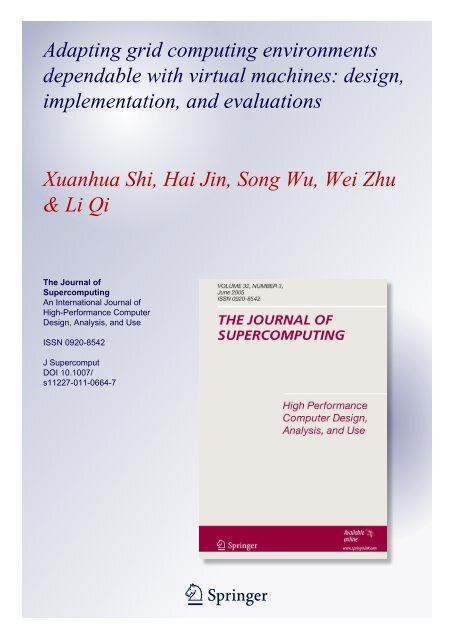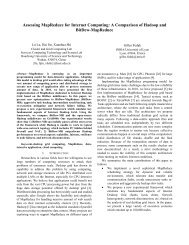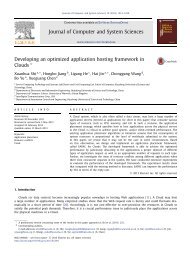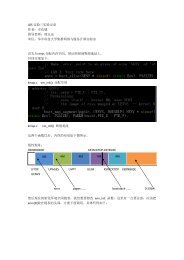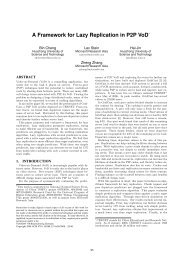Adapting grid computing environments dependable with virtual ...
Adapting grid computing environments dependable with virtual ...
Adapting grid computing environments dependable with virtual ...
Create successful ePaper yourself
Turn your PDF publications into a flip-book with our unique Google optimized e-Paper software.
Your article is protected by copyright andall rights are held exclusively by SpringerScience+Business Media, LLC. This e-offprintis for personal use only and shall not be selfarchivedin electronic repositories. If youwish to self-archive your work, please use theaccepted author’s version for posting to yourown website or your institution’s repository.You may further deposit the accepted author’sversion on a funder’s repository at a funder’srequest, provided it is not made publiclyavailable until 12 months after publication.1 23
Author's personal copyJ SupercomputDOI 10.1007/s11227-011-0664-7<strong>Adapting</strong> <strong>grid</strong> <strong>computing</strong> <strong>environments</strong> <strong>dependable</strong><strong>with</strong> <strong>virtual</strong> machines: design, implementation,and evaluationsXuanhua Shi · Hai Jin · Song Wu · Wei Zhu · Li Qi© Springer Science+Business Media, LLC 2011Abstract Due to its potential, using <strong>virtual</strong> machines in <strong>grid</strong> <strong>computing</strong> is attractingincreasing attention. Most of the researches focus on how to create or destroy a<strong>virtual</strong> execution <strong>environments</strong> for different kinds of applications, while the policyof managing the <strong>virtual</strong> <strong>environments</strong> is not widely discussed. This paper proposesthe design, implementation, and evaluation of an adaptive and <strong>dependable</strong> <strong>virtual</strong>execution environment for <strong>grid</strong> <strong>computing</strong>, ADVE, which focuses on the policy ofmanaging <strong>virtual</strong> machines in <strong>grid</strong> <strong>environments</strong>. To build a <strong>dependable</strong> <strong>virtual</strong> execution<strong>environments</strong> for <strong>grid</strong> applications, ADVE provides an set of adaptive policiesmanaging <strong>virtual</strong> machine, such as when to create and destroy a new <strong>virtual</strong> executionenvironment, when to migrate applications from one <strong>virtual</strong> execution environmentto a new <strong>virtual</strong> execution environment. We conduct experiments over a cluster toevaluate the performance of ADVE, and the experimental results show that ADVEcan improve the throughput and the reliability of <strong>grid</strong> resources <strong>with</strong> the adaptivemanagement of <strong>virtual</strong> machines.X. Shi () · H. Jin · S. WuServices Computing Technology and System Lab, Cluster and Grid Computing Lab, Schoolof Computer, Huazhong University of Science and Technology, Wuhan, 430074, Chinae-mail: xhshi@hust.edu.cnH. Jine-mail: hjin@hust.edu.cnS. Wue-mail: wusong@hust.edu.cnW. ZhuMicrostrategy, Hangzhou, 310012, Chinae-mail: zw283927@gmail.comL. QiIT Department, Operation Center, China Development Bank, Beijing, 100037, Chinae-mail: quick.qi@gmail.com
Author's personal copyX. Shi et al.Keywords Adaptive · Dependable · Virtual execution environment · Grid<strong>computing</strong>1 IntroductionNowadays, <strong>grid</strong> <strong>computing</strong> attracts more and more attentions in high performance<strong>computing</strong> area. By defining standardized protocols for discovering, accessing, monitoring,and managing remote computers, storage systems, networks, and other resources,<strong>grid</strong> technologies make it possible to allocate resources to applications dynamically,in an on-demand fashion [14]. However, while <strong>grid</strong>s offer users access tomany diverse and powerful resources, they do little to ensure that once a resource isaccessed, it fulfills user expectations for quality of service. The problem is that most<strong>grid</strong> platforms today do not support performance isolation: activities associated <strong>with</strong>one user or <strong>virtual</strong> organization (VO) [15] can influence the performance seen byother processes executing on the same platform in an uncontrolled way. Another seriousissue is that while <strong>grid</strong>s provide access to many resources <strong>with</strong> diverse softwareconfigurations, a user’s application will typically run only in a specific, customizedsoftware environment. Variations in operating systems, middleware versions, library<strong>environments</strong>, and file system layouts all pose barriers to application portability.Due to its potential, <strong>virtual</strong> machine is attractive to high performance computers.Virtual machines present the image of a dedicated raw machine to each user [22]. Thisabstraction is very powerful for <strong>grid</strong> <strong>computing</strong> because users then become stronglydecoupled from the system software of the underlying resource, and other users sharingthe resource. In terms of administration, <strong>virtual</strong> machines allow the configurationof an entire operating system to be independent from that of the computational resource;it is possible to completely represent a VM “guest” machine by its <strong>virtual</strong>state (e.g., stored in a conventional file) and instantiate it in any VM “host”, independentlyof the location or the software configuration of the host. Furthermore, we canmigrate running VMs to appropriate resources. Upon the above reasons, the merge of<strong>virtual</strong> machine and <strong>grid</strong> <strong>computing</strong> is promising.In this paper, we present an adaptive and <strong>dependable</strong> <strong>virtual</strong> environment for <strong>grid</strong><strong>computing</strong>, ADVE, which allows a <strong>grid</strong> client to define an environment in terms ofits requirements (such as resource requirements or software configuration), manageit, and then deploy the environment in the <strong>grid</strong>. Moreover, ADVE can change its configurationduring the runtime. For example, ADVE can handle the problem when andwhere to create a <strong>virtual</strong> execution environment, when to change the number of the<strong>virtual</strong> execution <strong>environments</strong>, and what kind of situation to migrate one applicationto another <strong>virtual</strong> execution environment. ADVE is implemented <strong>with</strong> <strong>virtual</strong> machinetechnology and the adaptive component [6]. The <strong>virtual</strong> machine technologysupports the definition, deployment, and destroying of the <strong>virtual</strong> execution environment,and the adaptive component handles the dynamic management of the <strong>virtual</strong>execution environment.We summarize our contributions as follows: (1) Using <strong>virtual</strong> machines, we implementan adaptable <strong>virtual</strong> execution environment, which can be adaptable accordingto user requirement and system status; (2) The real system evaluation shows thatADVE can make <strong>grid</strong> application more reliable.
Author's personal copy<strong>Adapting</strong> <strong>grid</strong> <strong>computing</strong> <strong>environments</strong> <strong>dependable</strong> <strong>with</strong> <strong>virtual</strong>Fig. 1 Components of ADVEThe remainder of this paper is organized as follows. Section 2 describes the architectureof ADVE. The implementation of VEE manager, a key component in ADVEwhich controls <strong>virtual</strong> machines, is presented in Sect. 3. In Sect. 4, the performanceevaluations are presented. Section 5 discusses the related work, and we conclude ourwork in Sect. 6 <strong>with</strong> a brief look at the future work.2 Architecture of ADVEIn this section, we first present the architecture of ADVE, and then discuss theadaptive model in ADVE, which makes dynamic actions according to the dynamicchanges of the <strong>grid</strong> <strong>environments</strong> and users’ requests. Later, the situations for adaptationis presented, and the policies and plans are also presented in this section.2.1 Components of ADVEAs illustrated in Sect. 1, ADVE is implemented <strong>with</strong> <strong>virtual</strong> machines and adaptivecomponents. The adaptive capability of ADVE is fulfilled by the Dynaco component[10]. Dynaco is a component which provides the capability for developers tomake adaptive decisions <strong>with</strong> policies and plans. The components of ADVE is shownin Fig. 1. ADVE is composed by three parts: the adaptive component, the <strong>virtual</strong>execution adaptor (VEA), and the <strong>virtual</strong> execution environment (VEE).– Adaptive components. Adaptive components are implemented <strong>with</strong> Dynaco. InADVE, the Dynaco gets the system information of the <strong>grid</strong> environment fromMonitor <strong>with</strong> pull or push method, the Monitor collects the information of the <strong>grid</strong>environment and job status, such as the network traffic, cpu load, and job requests.
Author's personal copyX. Shi et al.The Dynaco make adaptive decisions <strong>with</strong> the internal components of Decider andPlanner. Decider makes strategies to guide the planner to make an adaptive planfor executor.TheDecider makes the strategy based on the policy, which describescomponent-specific information required to make the decisions. The Planner is aprogram that modifies the components. The planner makes an adaptation plan thatmakes the component adopt a given strategy by the decider, and the plan-making isbased on the guide. Theexecutor take the adaptive action to the outsider. The Executoris a <strong>virtual</strong> machine to interpret the plan provided by the planner by meansof actions. For example creating a <strong>virtual</strong> execution environment is an action. Dynacohas implemented the dynamic framework; we only add adaptive policies andguides to guide the adaptation, for example, upon system overload, create an new<strong>virtual</strong> execution environment is a policy, and transfer the new image and deploythe new image can be the guide for the strategy of creating a new <strong>virtual</strong> execution.– Virtual execution adaptor. The <strong>virtual</strong> execution adaptor is a bridge between theDynaco and the <strong>virtual</strong> execution environment. Because Dynaco only handles theadaptive policy, the VEE creation and management should be handled by the <strong>grid</strong>middleware, and interaction between the <strong>virtual</strong> machine and the <strong>grid</strong> also needsa bridge to fix the gap, for example, creating a <strong>virtual</strong> execution environment andexecuting <strong>grid</strong> application on it should handle the interaction between <strong>grid</strong> middlewaresand <strong>virtual</strong> machines. The VEA have the following functions: passing therequest of a <strong>grid</strong> user to VEA and transferring the responses back from the VEEs tothe <strong>grid</strong> user; pulling and pushing the monitoring information of the VEEs to themonitor; passing the deployment and suspending action from Dynaco to VEEs;starting the applications on the <strong>virtual</strong> environment; and migrating one applicationfrom one VEE to another environment.– Virtual execution environment. The VEE is based on Globus <strong>virtual</strong> workspace[20]. The VEE refines the execution environment layer in <strong>grid</strong> architecture:rather than mapping jobs directly onto hardware resources, VEE maps jobs to preconfiguredexecution <strong>environments</strong> which can then be mapped to <strong>grid</strong> resources.Since a VEE may exist beyond its deployment, and may in fact be deployed manytimes on different resources during its lifetime, two new services are introduced:VEE Repository which provides a management interface to execution environment,and VEE Manager which orchestrates their deployment. In order to createa VEE instance, VEA contacts the VEE Factory <strong>with</strong> a VEE description by XMLschema. A negotiation process may take place to ensure that the VEE is created ina policy controlled way. The newly created VEE is registered <strong>with</strong> a VEE Repository,which provides a <strong>grid</strong> service interface allowing for inspection and managementof VEE and keeps track of resources implementing VEE such as <strong>virtual</strong>machine images. As a result of creation the client is returned a WSRF [8] endpointreference (EPR) to the workspace. To deploy a VEE on a specific resource,VEA contacts a VEE Manager <strong>grid</strong> service on that resource and presents it theVEE’s EPR. The VEE Manager allows a client to deploy/undeploy, start/stop, andalso pause/unpause execution environment. Based on such functions, the adaptivecomponents can make adaptive actions to improve the execution performance.
Author's personal copy<strong>Adapting</strong> <strong>grid</strong> <strong>computing</strong> <strong>environments</strong> <strong>dependable</strong> <strong>with</strong> <strong>virtual</strong>2.2 Model of adaptive <strong>virtual</strong> environmentAs mentioned above, ADVE tries to provide a flexible and <strong>dependable</strong> environmentfor <strong>grid</strong> applications. The targets of ADVE system is to improve the ratio of the<strong>grid</strong> resources’ usage and to enhance the application reliability. These targets arefulfilled by the adaptive model in ADVE system. To illustrate the adaptive model,some definitions are presented first.Definition 1 Throughput (T): Throughput of a <strong>grid</strong> resource (R) is defined as thenumber of requests that R can handle in a specific time interval (t).Definition 2 Reliability (r): Reliability of a <strong>grid</strong> application is defined as the possibilitythat no application failure has occurred in a specific time interval (t).Definition 3 Adaptive Overhead (AO): The adaptive overhead is defined as the sumof the Dynaco starting time and passing adaptive instruction to actions. The time forpassing adaptive instruction to actions refers to the time that the instruction passingfrom decider to VEA.Definition 4 Virtual Machine Overhead (VMO): The <strong>virtual</strong> machine overhead isdefined as the execution time for starting/stopping, pausing/unpausing, and deploying/undeployingof the <strong>virtual</strong> machine.To improve the throughput of the <strong>grid</strong> resources, ADVE creates a new VEE dynamicallyaccording to user requests and resources usage. To enhance the reliabilityof an application, ADVE creates a new VEE to migrate the application or to create anreplica of the application. ADVE uses a decision-making method to make adaptiveactions to improve the system performance. The target equation for decision makingis shown in (1).⎧⎪⎨ Maxmum(T );Maxmum(r);(1)⎪⎩Minmum(AO ∗ i + VMO ∗ j),where i in (1) refers to the number of actions that Dynaco takes, and j refers to thenumber of <strong>virtual</strong> machine management. According to (1), the adaptive model inADVE is a multiobjective decision making problem, and ADVE takes Analytic HierarchyProcess Method (AHP) to make decisions [30].2.3 Situations for adaptationTo illustrate the adaptive model, we first present the situations for adaptation. Generally,there are three situations that ADVE will make adaptive actions to improve theperformance, they are as follows:– Number of request changes. When there are new users’ requests arrive, the load foreach VEE changes, and ADVE will compute the decision-making target function
Author's personal copyTable 1 Policies for the changeof user request numbers Situation StrategyX. Shi et al.{upon request increase over a threshold}{upon request decrease than a threshold}create a new VEEundeploy a VEEFig. 2 Plan template forcreating a new VEEAlgorithm: Create a new VEEPreparing a <strong>virtual</strong> machine image;Searching available resources for deploying;Transferring <strong>virtual</strong> machine as <strong>grid</strong> services;Returning VEEID;to decide whether to create a new VEE or not. At the other side, when the numberof users’ request decrease, ADVE will compute the decision-making target functionto decide whether to stop a VEE to decrease the management overhead andexecution management of a <strong>virtual</strong> machine.– Computational load changes. When one computational resources is overload, forexample CPU is overload, ADVE will create a new VEE to handle this. When somecomputational load decrease, ADVE will undeploy a VEE to reduce the managementoverhead.– Resources down. In <strong>grid</strong> environment, it is very common that some resources aredown during job execution. When some resources down, ADVE will create newVEEs on new available resources to take over the request on failed resources.2.4 Adaptive policies and plansBased on the situation analysis above, we can present the adaptive policies and theplans in ADVE, the policies and the plans are defined <strong>with</strong> Java language whichcan be recognized and interpreted by Dynaco system. To illustrate policies and planssimply, we take a natural language to present them. The policy for the change ofrequest numbers can be given as Table 1.In Table 1, there are two actions that need plans to guide, and they are create anew VEE and undeploy a VEE. Figure 2 shows the plan template for creating a VEE.As shown in Fig. 2, to create a new VEE, ADVE needs to take the following actions:preparing a <strong>virtual</strong> machine image for the VEE; searching available resources to deploythe <strong>virtual</strong> machine; transferring the <strong>virtual</strong> machine to the selected resources;deploying the <strong>virtual</strong> machine as <strong>grid</strong> services; and returning the ID of VEE to theVEE manager.3 Implementation of VEE managerAs illustrated above, the VEE manager is a controller for <strong>virtual</strong> machines; the controllingfunction includes monitoring, deploying, and load balancing. The load balancingfunction refers to live migration of <strong>virtual</strong> machines which can lead to loadbalancing for back-end severs.
Author's personal copy<strong>Adapting</strong> <strong>grid</strong> <strong>computing</strong> <strong>environments</strong> <strong>dependable</strong> <strong>with</strong> <strong>virtual</strong>Fig. 3 Architecture of themonitor3.1 MonitorTo launch a VEE, the VEE manager needs a clear understanding of the up-to-theminutesystem conditions. Monitor is the fundamental component of VEE manager.In ADVE, the Monitor is implemented by three module, the Monitor Center, which isdeployed on the front-end of the servers, the Daemon, which is a distributed moduledeployed on Virtual Machine Manager (VMM), and the Agent which is deployedinside the guest OS on the cluster nodes. The architecture of the Monitor is shown inFig. 3.Initially, the Agent obtains system information of guest OS while Daemon acquiresphysical resource information and VMM information of Host OS. Next, MonitorCenter gathers information from each Daemon and performs analysis processingto maintain an overall information record. Then, according to the status, the VEEmanager determines what to do, e.g., migrating one VM from one node to anothernode.Agent mainly concerns about processes or jobs running inside a <strong>virtual</strong> machineas well as their resource usage information. Such information provides basis for adjustingreserved physical <strong>computing</strong> resource for <strong>virtual</strong> machines. Meanwhile, manytypes of statistical data and analytical data are offered to administrators to help themgain a deeper insight into the system. Daemon focuses on physical <strong>computing</strong> resourceusage in a physical machine. Such information is crucial for deploying <strong>virtual</strong>machines. As resource is limited, we cannot deploy too many <strong>virtual</strong> machines on asingle node arbitrarily. Before creating a <strong>virtual</strong> machine, VEE manager examines theinformation of physical machine carefully to make sure that there is enough physical<strong>computing</strong> resource left. Moreover, to migrate a <strong>virtual</strong> machine also needs checkingthe information beforehand because it requires sufficient memory available in targetphysical machine.Monitor Center supervises the availability of every single physical node. Eachphysical node has two states: valid or invalid. A physical node is invalid implies thatany operation related to this node would fail. For that a valid node could becomeinvalid at any moment and vice versa, Monitor Center updates the states of physicalmachines periodically. Sometimes analysis processing is necessary especially whendealing <strong>with</strong> many <strong>virtual</strong> machines. For example, IP addresses of <strong>virtual</strong> machines
Author's personal copyX. Shi et al.could be displayed in a list, which, apparently, fails to intuitively reveal the networkinterconnections between <strong>virtual</strong> machines. Monitor Center analyzes the relationshipof IP addresses and then generates a diagram depicting network topological structure.3.2 DeploymentTo launch a VEE for an application, VEE manager needs to deploy a <strong>virtual</strong> machine;the traditional process is extremely time-consuming. The process goes like this: first,create a <strong>virtual</strong> machine <strong>with</strong> a blank disk image; second, install an operating system(Guest OS) on this <strong>virtual</strong> machine; and finally, setup the application and its requirements.In ADVE, we present several ways to decrease the deployment time.Firstly, VEE manager offers dozens of <strong>virtual</strong> machine images <strong>with</strong> preinstalledoperating system as <strong>virtual</strong> machine templates. By cloning <strong>virtual</strong> machine template,we can deploy one or more <strong>virtual</strong> machines very easily and quickly. Therefore, itfrees administrators from installing the operating system over and over. Templatesare managed by the Monitor Center while cloned images are accessed by clusternodes on which Daemon runs.Secondly, VEE manager takes incremental template deployment for <strong>virtual</strong> machines.It takes a long time to duplicate dozens of disk images for <strong>grid</strong> users. An incrementaldisk image can be used to store the changes to another disk image, <strong>with</strong>outactually affecting the contents of the original image; incremental disk image and basedisk image combined to be an integrated disk image for a <strong>virtual</strong> machine. Base diskimage is read-only, which means that all write operation is acted on the incrementaldisk image. When a new job wants to read an area, the VEE manager first checksif that area is allocated <strong>with</strong>in the incremental disk image. If not, the VEE managerreads the area from the base disk image. The VEE manager takes the QCOW imageformat for storing the <strong>virtual</strong> machine image. The QCOW image format is one of thedisk image formats supported by the QEMU processor emulator. The share-base diskimage and incremental disk image deployment management is shown in Fig. 4.Fig. 4 Incremental template deployment
Author's personal copy<strong>Adapting</strong> <strong>grid</strong> <strong>computing</strong> <strong>environments</strong> <strong>dependable</strong> <strong>with</strong> <strong>virtual</strong>3.3 Load balancingTo raise resource utilization ratio, the VEE manager presents two levels of loadbalancingfunctions: The first level is dynamic allocating memory and CPU allocationfor <strong>virtual</strong> machines on a single physical machine (single-node level), and theother level refers to live migration of <strong>virtual</strong> machines which can adjust resourcesbetween physical nodes (multinode level). In single-node level, if a <strong>virtual</strong> machineis far from fully utilized, the VEE manager will cut down its <strong>computing</strong> resource andgive more resources to other <strong>virtual</strong> machines. Reversely, if a <strong>virtual</strong> machine is overloaded,the VEE manager is supposed to promote its performance by appropriatelyreserving more physical resources for it. As to the multinode level, one case is that aphysical machine would be overloaded due to too many <strong>virtual</strong> machines competingfor limited CPU and memory resources. Monitor Center would detect this situationand generate a migrating plan for the VEE manager, then the VEE manager executesthe plan to move <strong>virtual</strong> machines from an overloaded physical machine to comparativelyidle physical machines. Another case is that the physical resource is toofragmentary resulting from <strong>virtual</strong> machines being created and destroyed. Resourcefragments may prevent us from deploying more <strong>virtual</strong> machines. If this happens,the Monitor Center would suggest another migrating plan for the VEE manager, andthe VEE manager will combine resource fragments into big pieces by making <strong>virtual</strong>machines assembled in the same physical machine.4 Performance evaluationIn this section, we present the performance results of the implementation. Firstly,we evaluate the throughput of ADVE compared <strong>with</strong> classical <strong>grid</strong> implementation,Secondly, we evaluated the reliability of application deployed on ADVE. Finally, wepresent the performance for the VEE manager.4.1 ThroughputAs mentioned above, ADVE is implemented <strong>with</strong> Globus <strong>virtual</strong> workspace. ADVEuses Xen (Version 3.0) as the implementation of the <strong>virtual</strong> machine. The <strong>grid</strong> servicesand infrastructure are implemented by using GT4 (Version 4.0.5). The VMimage is Debian (Version 3.1) <strong>with</strong> the size of about 1 GB. To stage a VEE, the VEEManager transfers the <strong>virtual</strong> machine image (including description metadata and theimplementation-specific image) from the VEE Repository to the host node by usingGridFTP [2]. One node at the Wuhan site of ChinaGrid [18] is chosen to evaluate thethroughput of ADVE. The node is equipped <strong>with</strong> a 2.33 GHz Xeon CPU, 4 GB memory,and 60 GB disk. The node is configured to run single-CPU guest VMs. Oncethe transferring of VM image is complete, the VEE Manager waits for the VEA tostart the VEE, which includes creating a VEE resource, loading the VM image intomemory, and booting the VM.The performance impact of <strong>virtual</strong> machines on applications has been shown tobe small (typically under 5% of slowdown) for different application classes [3]. In
Author's personal copy<strong>Adapting</strong> <strong>grid</strong> <strong>computing</strong> <strong>environments</strong> <strong>dependable</strong> <strong>with</strong> <strong>virtual</strong>Fig. 6 Reliability of image greytransformation programcheckpoint interval of the application is about 6 seconds, and the checkpoint overheadand the recovery time from the checkpoint image are about 0.5 seconds. We setthe down time of the <strong>grid</strong> middleware and the VEE as 60 seconds. The evaluationresults are shown in Fig. 6. We experiment one thousand jobs for each mean time tofailure (MTTF) testing, and the execution time in Fig. 6 is the mean time of theseexecutions. Figure 6 shows the relationship between the execution time and the meantime to failure. In Fig. 6,thex-axis shows the MTTF, the y-axis shows the mean timeof these executions. From Fig. 6, we can see the following:(1) When the MTTF is less than 60 seconds, the execution time over ADVE is muchless than the system <strong>with</strong>out adaptive VMs. This shows that ADVE is suitable forlong-duration jobs over unreliable <strong>grid</strong> <strong>environments</strong>.(2) If the MTTF is longer than 120 seconds, the execution time difference betweenthe ADVE and the non-adaptive system is very small. The difference in decreasingcan be explained as this: an application runs over a reliable environment canget a good reliability, so the improvement will not be so obvious. Figure 6 alsoshows that the execution time over ADVE is a little smaller than over nonadaptivesystems; this shows that an application can more reliability of the applicationseven over reliable <strong>environments</strong> <strong>with</strong> ADVE than <strong>with</strong> nonadaptive system,despite of the extra overhead of ADVE.4.3 VM deploymentVM deployment is a time consuming work in ADVE, we evaluate the deployment onan IBM HS21 cluster at the Wuhan site of ChinaGrid, each HS21 node is equipped<strong>with</strong> 2-way, 4-core Intel Xeon CPU E5345 2.33 GHz and 8 GB memory, and eachHS21 node features 73 SCSI hard disk. The HS21 nodes are connected <strong>with</strong> a GigabitEthernet network and a 10 Gbps Infiniband. We evaluate three VM deploymentmethods: (1) create blank images and install operating system; (2) create images byduplicating from VM templates; (3) create incremental image based on VM templates.We are trying to deploy a certain number of VMs <strong>with</strong> Windows XP installed.
Author's personal copyX. Shi et al.Fig. 7 Time for deploymentEach VM is allocated 1 processor and 512 MB memory. On each single node, wedeploy 4 VMs at most, thus the deployment time would not be extended due to slowresponse of overloaded nodes.Figure 7 shows the deployment time of three different methods. From Fig. 7, wecan observe that installing operating system for all VMs is a time-consuming work,about 40 minutes for each VM. By duplicating from VM templates, the VEE managerreduces the deployment time to approximately 6 minutes per VM which accounts for1/7 of that of manual deploying. The deployment time is dramatically decreasedagain by utilizing incremental images; the average deployment time is just 0.3 minutesper VM which only accounts for 1/20 of the second method and accounts for1/120 of original method. Besides the shortening of deployment time, the I/O consumptionis also reduced, which is an important feature for running data-intensiveapplications.To evaluate the overhead for incremental deployment, we run vBench [29] in eachVM and compare the result <strong>with</strong> that of a VM using a nonincremental image. Theoverhead is shown in Fig. 8.From Fig. 8, we can observe that the disk I/O overhead is around 10% if thereis only one incremental image basing on a VM template. When the number of VMssharing one base image is increased, the average disk I/O overheads slowly decreaseand reach the bottom of 5% at the point of 20 VMs. The reason for the decreasingof overheads is that Linux caches disk blocks, which leads to an improved performancefor a frequently accessed base image. The result shows that the incrementaldeployment in the VEE manager is suitable for large-scale <strong>grid</strong> <strong>environments</strong>.5 Related workFor the flexibility of resource management and user management, the use of the <strong>virtual</strong>machine is very popular in <strong>grid</strong> <strong>computing</strong>. Figueiredo et al. [13] proposes anoverview of merge <strong>virtual</strong> machine and <strong>grid</strong> <strong>computing</strong>. The In-Vigo project [1][21]
Author's personal copy<strong>Adapting</strong> <strong>grid</strong> <strong>computing</strong> <strong>environments</strong> <strong>dependable</strong> <strong>with</strong> <strong>virtual</strong>Fig. 8 Deployment overheadmade substantial progress in this direction while the Virtuoso [27] and VIOLIN [17]projects explored networking issues arising from use of VMs in this setting. Globus<strong>virtual</strong> workspace proposes the <strong>virtual</strong> workspace (VW) abstraction to describe such<strong>environments</strong> and showed how this abstraction can be implemented by using <strong>virtual</strong>machines for <strong>grid</strong> <strong>computing</strong> [20]. Sotomayor et al. propose a system, Haizea, combiningbatch execution and leasing using <strong>virtual</strong> machines [25], which implementsleases as <strong>virtual</strong> machines (VMs), leveraging their ability to suspend, migrate, andresume computations and to provide leased resources <strong>with</strong> customized application<strong>environments</strong> in a cluster. ADVE share some features of Haizea. Attempts to capturerequirements of an execution environment to some extent and automate their deploymenthave also been made before, for example, the <strong>virtual</strong> appliance project [24]uses<strong>virtual</strong> machines configured based on descriptions in a configuration language to easeadministrative burden, and the Cluster on Demand (COD) project [7] allows a userto choose from a database of configurations to configure a partition of a cluster. TheXenoserver project [28] is building an infrastructure for wide-area distributed <strong>computing</strong>based on <strong>virtual</strong> machines similar to Globus <strong>virtual</strong> workspace. We differ fromthese projects by our focus on the dynamic features of managing <strong>virtual</strong> execution environmentfor <strong>grid</strong> applications during the application runtime. OpenNebula [23] andEucalyptus [12] are two open-source projects, which aimed at building cloud <strong>computing</strong>[26] tool to manage the complexity and heterogeneity of distributed data centerinfrastructures. These two projects do the similar work as the VEE in ADVE, butADVE address more on the adaptive issue for <strong>grid</strong> <strong>computing</strong>.The adaptive <strong>computing</strong> is not a new concept, for example, an adaptive schedulingmethod is presented in [4], while this method does not give full control of applicationsto the developers. In [11], a Program Control Language is proposed, which providesa novel means of specifying adaptations in distributed applications. Gorender et al.presented an adaptive programming model for fault-tolerant distributed <strong>computing</strong>,which provides upper-layer applications <strong>with</strong> process state information accordingto the QoS [16]. In [5], a component-based autonomous repair management in distributedsystems is presented, which provides the adaptive replication ability to man-
Author's personal copyX. Shi et al.age the subsystems. The related work has the similar concepts to ADVE, whereas,ADVE focuses on providing an adaptive execution environment for <strong>grid</strong> applicationswhich targets fault-tolerance and load balancing for <strong>grid</strong> <strong>computing</strong> <strong>with</strong> adaptivetechnology. DRIC framework proposed an policy-based fault-tolerance architecturefor <strong>grid</strong> applications [19]. DRIC has the similar concept to make a <strong>dependable</strong> <strong>grid</strong><strong>computing</strong> environment for <strong>grid</strong> applications as ADVE, while DRIC focus on providefault-tolerance technique for applications themselves <strong>with</strong> the help of the <strong>grid</strong> middleware,such as checkpointing the application, resubmitting the application, whileADVE focuses on creating adaptive execution <strong>environments</strong> for <strong>grid</strong> applications.An adaptive replication middle-ware is presented by MEAD research group [9]. Justlike DRIC, MEAD also targets the fault-tolerance of the applications themselves, notthe <strong>environments</strong>.6 Conclusions and future workIn this paper, we present the design, implementation, and evaluation of an adaptiveand <strong>dependable</strong> <strong>virtual</strong> execution environment, ADVE. ADVE merges the idea ofadaptive <strong>computing</strong> and <strong>virtual</strong> machine technology to provide a <strong>virtual</strong> dynamicexecution environment for <strong>grid</strong> applications. ADVE deploys or undeploys <strong>virtual</strong>machines over physical <strong>grid</strong> resources based on <strong>grid</strong> environment changes and <strong>grid</strong>users’ requests changes, such as number of service requests changes, resource loadchanges. The experiment conducted in this paper shows that ADVE can improve thethroughput of the <strong>grid</strong> resources and the reliability of <strong>grid</strong> applications comparing<strong>with</strong> the classical <strong>grid</strong> environment.Our future work includes the following directions: (1) We will improve ADVE<strong>with</strong> more dynamic policies to enhance the reliability of <strong>grid</strong> applications and toimprove the flexibility of management of <strong>virtual</strong> machines. (2) We will improve theperformance of <strong>virtual</strong> machine image transferring <strong>with</strong> I/O scheduling technology.(3) To improve the performance of the <strong>virtual</strong> machine deployment, we will designnew <strong>virtual</strong> machine deployment techniques, such as template inside memory.Acknowledgements This work is partly funded by the National 973 Basic Research Program of Chinaunder Grant No. 2007CB310900, NSFC under Grant No. 60973037 and 61073024, Wuhan ChenguangProgram under Grant No. 201050231075, the SRF for ROCS, SEM, NCET Program Grant NCET-07-0334.References1. Adabala S, Chadha V, Chawla P, Figueiredo R, Fortes J, Krsul I, Matsunaga A, Tsugawa M, ZhangJ, Zhao M, Zhu L, Zhu X (2004) From <strong>virtual</strong>ized resources to <strong>virtual</strong> <strong>computing</strong> <strong>grid</strong>s: the In-VIGOsystem. In: Future generation computer systems2. Allcock W, Bresnahan J, Kettimuthu R, Link M, Dumitrescu C, Raicu I, Foster I (2005) The globusstriped GridFTP framework and server. In: Proceedings of the 2005 ACM/IEEE conference on super<strong>computing</strong>3. Barham P, Dragovic B, Fraser K, Hand S, Harris T, Ho A, Neugebar R, Pratt I, Warfield A (2003) Xenand the art of <strong>virtual</strong>ization. In: ACM symposium on operating systems principles (SOSP)
Author's personal copy<strong>Adapting</strong> <strong>grid</strong> <strong>computing</strong> <strong>environments</strong> <strong>dependable</strong> <strong>with</strong> <strong>virtual</strong>4. Berman F, Wolski R, Casanova H, et al (2003) Adaptive <strong>computing</strong> on the <strong>grid</strong> using AppLes. IEEETrans Parallel Distrib Syst 14(4):369–3825. Bouchenak S, Boyer F, Hagimont D, et al (2005) Architecture-based autonomous repair management:an application to J2EE clusters. In: Proceedings of the IEEE symposium on reliable distributedsystems6. Buisson J, André F, Pazat J (2005) A framework for dynamic adaptation of parallel components. In:Proceeds of ParCo 2005, Sep7. Chase J, Grit L, Irwin D, Moore J, Sprenkle S (2003) Dynamic <strong>virtual</strong> clusters in a <strong>grid</strong> site manager.In: Proceedings of 12th international symposium on high performance distributed <strong>computing</strong>(HPDC-12)8. Czajkowski K, Ferguson D, Foster I, Frey J, Graham S, Sedukhin I, Snelling D, Tuecke S, VambenepeW (2004) The WS-Resource framework. www.globus.org/wsrf9. Dumitras T, Srivastava D, Narasimhan P (2005) Architecting and implementing versatile dependability.In: Architecting <strong>dependable</strong> systems, vol 310. Dynaco (2011) http://gforge.inria.fr/projects/dynaco11. Ensink B, Stanley J, Adve V (2003) Program control language: a programming language for adaptivedistributed applications. J Parallel Distrib Comput 62(11):1082–110412. Eucalyptus (2011) http://www.eucalyptus.com13. Figueiredo R, Dinda P, Fortes J (2003) A case for <strong>grid</strong> <strong>computing</strong> on <strong>virtual</strong> machines. In: Proceedingsof the 23rd international conference on distributed <strong>computing</strong> systems14. Foster I (2002) The <strong>grid</strong>: a new infrastructure for 21st century science. Phys Today 55(22):42–4715. Foster I, Kesselman C, Tuecke S (2001) The anatomy of the <strong>grid</strong>: enabling scalable <strong>virtual</strong> organizations.Int J Supercomput Appl 15(3):200–22216. Gorender S, de Araújo Macédo RJ, Raynal M (2007) An adaptive programming model for faulttolerantdistributed <strong>computing</strong>. IEEE Trans Dependable Secure Comput 4(1):18–3117. Jiang X, Xu D (2003) VIOLIN: <strong>virtual</strong> internetworking on overlay infrastructure. Department of ComputerSciences Technical Report CSD TR 03- 027, Purdue University18. Jin H, Shi X, Qi L (2005) Use case study of <strong>grid</strong> <strong>computing</strong> <strong>with</strong> CGSP. In: Proceedings of the humansociety@Internet19. Jin H, Shi X, Qiang W, Zou D (2006) DRIC: <strong>dependable</strong> <strong>grid</strong> <strong>computing</strong> framework. IEICE Trans InfSyst, E89-D(2):612–62320. Keahey K, Foster I, Freeman T, Zhang X, Galron D (2005) Virtual workspaces in the <strong>grid</strong>. In: Proceedingsof Europar 2005, Lisbon, Portugal, September21. Krsul I, Ganguly A, Zhang J, Fortes J, Figueiredo R (2004) VMPlants: providing and managing <strong>virtual</strong>machine execution <strong>environments</strong> for <strong>grid</strong> <strong>computing</strong>. In: Proceeding of the super<strong>computing</strong> (SC’XY)conference, Pittsburgh, PA22. Meyer RA, Seawright LH (1970) A <strong>virtual</strong> machine time sharing system. IBM Syst J 9(3):199–21823. OpenNebula (2011) http://opennebula.org/24. Sapuntzakis C, Brumley D, Chandra R, Zeldovich N, Chow J, Lam MS, Rosenblum M (2003) Virtualappliances for deploying and maintaining software. In: Proceedings of the 17th large installationsystems administration conference (LISA ’03)25. Sotomayor B, Keahey K, Foster I (2008) Combining batch execution and leasing using <strong>virtual</strong> machines.In: Proceedings of the 17th international symposium on high-performance distributed <strong>computing</strong>(HPDC)26. Sotomayor B, Montero RS, Llorente IM, Foster I (2009) Virtual infrastructure management in privateand hybrid clouds. IEEE Internet Comput 13(5):14–2227. Sundararaj A, Dinda P (2004) Towards <strong>virtual</strong> networks for <strong>virtual</strong> machine <strong>grid</strong> <strong>computing</strong>. In: Proceedingsof the 3rd USENIX conference on <strong>virtual</strong> machine technology28. Xenoserver project (2011) http://www.xenoservers.net/29. Yuan P, Jin H, Ye D, Cao W, Yan Y, Xie X (2009) vBench: a micro-benchmark for file—I/O performanceof <strong>virtual</strong> machines. In: Proceedings of the IEEE Asia-Pacific services <strong>computing</strong> conference(APSCC 2009)30. Zahedi F (1986) The analytic hierarchy process—a survey of the method and its applications. Interfaces16(4):96–108


